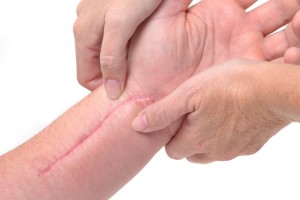The Scar Report: Different Types Of Scars And Scar Treatment Options
 Scarring is a normal part of life, but there are ways you can reduce the visible appearance of scars depending on the type of scar you are dealing with. Any cut to the skin can result in a scar and it’s hard to go your whole life without experiencing multiple injuries to your epidermis.
Scarring is a normal part of life, but there are ways you can reduce the visible appearance of scars depending on the type of scar you are dealing with. Any cut to the skin can result in a scar and it’s hard to go your whole life without experiencing multiple injuries to your epidermis.
Scarring is a natural part of the healing process. How badly a scar looks has to do with a number of factors including:
- Treatment immediately after injury and thereafter.
- Location of your injury
- Size and depth of the wound
- Your genes, age, gender and ethnicity
4 Common Types Of Scars
Different types of scars exist and may require different types of treatment. Some common types of scars include keloid, hypertrophic, acne and contracture scars.
Keloid Scars: Keloid scars are caused when a wound heals too quickly and causes further problems that stretch outside of the original injury. As a result you may experience difficulty moving the affected area. This type of scar may require surgery to remove the scar, silicone sheets to flatten the scar, or steroid injections.
Help prevent the development of keloid scars by using pressure treatment or silicon gel pads after injury. This type of scarring is most common with dark skin.
Hypertrophic Scars: This type of scar is puffy, red and comparable to a keloid scar, although they do not extend beyond the lines of your original injury as keloid scars can. Silicone sheets and injectable steroids to reduce inflammation are often used as treatment.
Contracture Scars: This type of scar results after your skin is burned. This type of scar causes the skin to tighten, which can actually immobilize the area. Contracture scars extend deep beneath the skin, impacting muscles and nerves.
Acne Scars: Severe acne can cause several types of scarring, including deep pits and more wavelike scars. Recommended treatments will vary depending on the type of acne scars you have.
3 Of The Most Popular Scar Treatments
1. Creams, Ointments, Gels
Prescription or over-the-counter ointments are available in vast assortment for scar reduction. Cuts, wounds and other mild to moderate injuries can be treated with these options. If your scars are related to plastic surgery ask your surgeon from the get-go if there are over-the-counter or prescription ointments you can use to reduce scarring.
Certain antihistamine creams used to treat scarring may cause itching and skin sensitivity. Other over-the-counter treatments available include gels, creams, and ointments, as well as silicone gel sheets and pressure treatment.
2. Surgery
Surgery is an option to remove more serious scars. Different types of surgeries include excision, dermabrasion, laser surgery or skin grafts. Skin grafts are most common in burn victims and include taking skin from another area of your body and grafting it to the damaged location. Surgery is an option when scarring is impairing your overall daily life and ability to function.
3. Injections
Steroid injections are commonly used to treat scarring that protrudes out of the skin. For instance, keloids and hypertrophic scars are commonly treated with injection steroids. Injections may be paired with other forms of treatment or used solely.
Collagen fillers may also be injected and used to temporarily treat pitted scars in some cases.
Will Your Insurance Cover Scar Treatments?
Patients often ask if insurance will help cover scar treatments. If your scarring impairs your day-to-day life there is a chance treatment will be covered through your health insurance provider. A doctor can take photographs of your scarring to help argue on your behalf for the necessity of treatment.
If scar treatments are completely cosmetic you are way more likely to pay out of pocket. If scars were caused by cosmetic surgery you can always check with your health insurance but in most cases insurance will not cover anything related to cosmetic procedures. (Reference)
How To Help Prevent Scarring After Injury
Scars are mainly made of collagen, which is a protein that can be found in the second layer of your skin. Any injury can result in scarring but the after care you receive for your injury will reduce your risk of scarring, or at least reduce the appearance of any scars.
- Cuts need to be properly treated, cleaned, and wrapped to prevent infection and worsening of the wound.
- Do not ever pick at a wound, as this will increase the chance for scarring to occur.
- Don’t use hydrogen peroxide or Vitamin E on new cuts as both have been found to delay healing and increase risk for scarring.
- Don’t allow the sun to see your wounds while they heal.
Visit Urgent Medical Center for any mild to moderate cuts, wounds or scars. (Reference)
